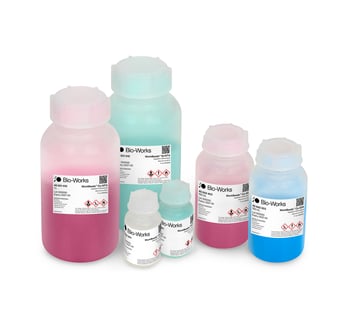Immobilized metal-ion affinity chromatography (IMAC) resins
WorkBeads resins for immobilized metal-ion affinity chromatography (IMAC) enable rapid purification of His-tagged proteins or other proteins with an affinity for metal ions.
Immobilized metal-ion affinity chromatography (IMAC) resins
IMAX resins that purify his-tagged proteins efficiently
WorkBeads™ are agarose-based chromatographic resins designed for separations requiring optimal capacity and purity. There are three different chelating ligands that WorkBeads IMAC resins are based on.
First are WorkBeads IDA (iminodiacetic acid) and WorkBeads NTA (nitrilotriacetic acid), which can be charged or are pre-charged with four different metals (Ni2+, Co2+, Cu2+, and Zn2+). Different combinations of ligands and metals give unique selectivities. Pre-charged IDA and NTA-based IMAC resins can be stripped, cleaned, and recharged with fresh metal ions.
- Pre-charged resins with different metal ions for optimal purity of the target protein
- High binding capacity and flow properties
- Reliable and reproducible results
The third resin is WorkBeads NiMAC, a nickel pre-charged resin with very low nickel leakage and tolerant against chelating agents (EDTA) and reducing substances (DTT). This resin is optimal for the purification of, e.g. eukarytic cell feeds, which often containing these substances.
- Resin with extra strongly bound Ni2+ resulting in extremely low nickel ion leakage
- Highly resistant to reducing agents up to 20 mM DTT
- Highly resistant to chelating substances present in eukaryotic extracts or up to 20 mM EDTA
- High purity and reproducible results
For optimization, an initial screening is recommended with the different WorkBeads IMAC resins to identify the optimal combination of ligand and metal ion.
Principle of immobilized metal-ion affinity chromatography (IMAC)
IMAC utilizes the affinity of histidine, cysteine, and tryptophan amino acid side chains on the protein surface for binding to transition metal ions, such as Ni2+, Co2+, Cu2+, and Zn2+, immobilized via a metal chelating ligand on the chromatography resin.
IMAC is commonly used for the purification of recombinant His-tagged proteins. A His-tag is usually composed of six to ten histidyl groups and is typically placed at the N- or C-terminus of the target protein, although other positions are possible. His-tagged proteins will bind to the chelating ligand (through the metal ion), and unbound material will pass through the column. Bound proteins are desorbed by stepwise or gradient elution using a competing agent or by applying a low pH buffer.
WorkBeads give unbeatable results for biomolecule purification
WorkBeads are agarose-based chromatographic resins manufactured using a proprietary method that results in porous beads with tight size distribution and exceptional mechanical stability. Agarose-based matrices have been successfully used for decades in biotechnology purification, from research to production scale, due to their exceptional compatibility with biomolecules, including proteins, peptides, nucleic acids, and carbohydrates. WorkBeads resins are designed for separations requiring optimal capacity and purity.
Don't hesitate to contact us about receiving a sample resin to ensure purification success on your target molecule.